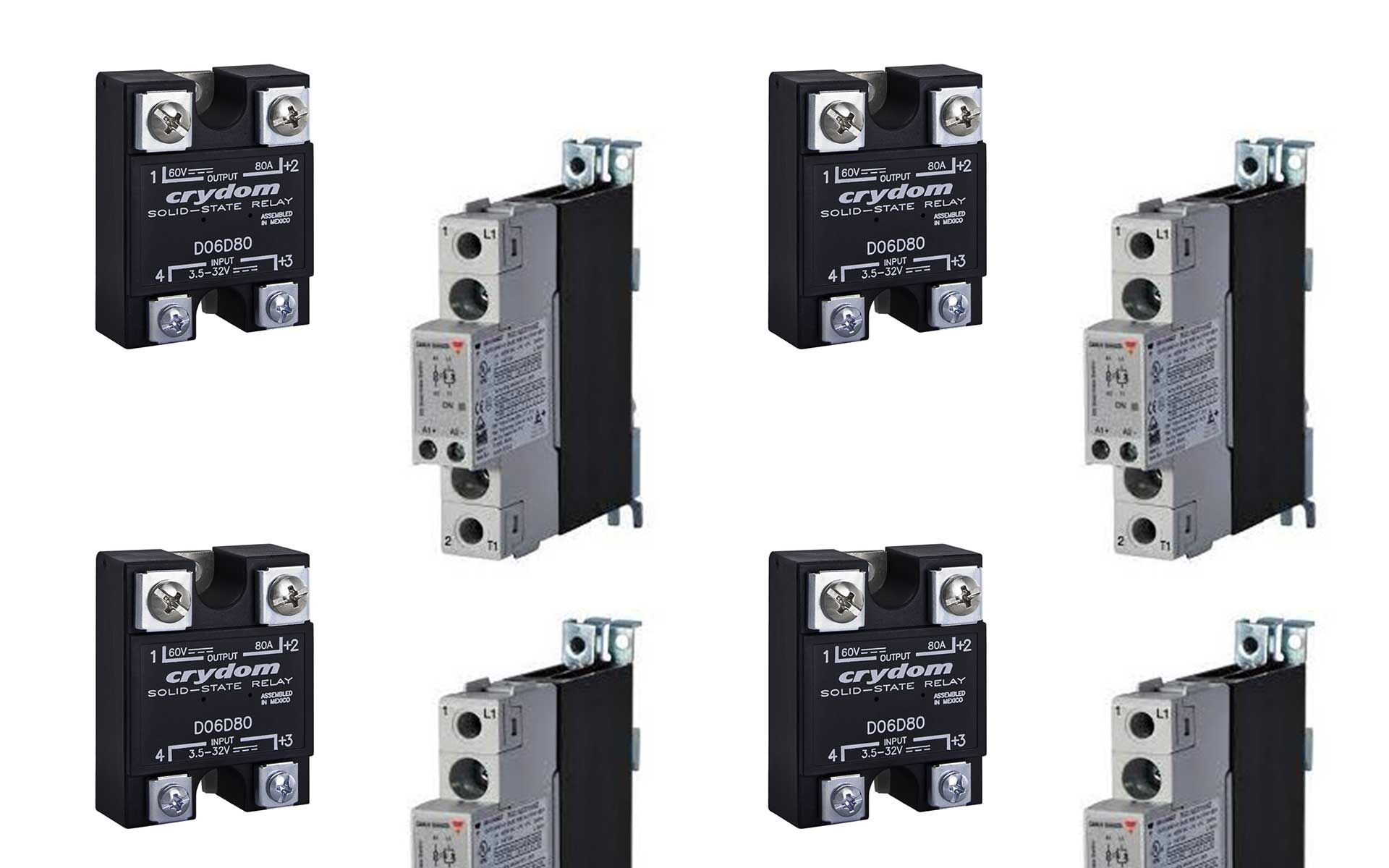Understanding electrical component differences is essential to avoiding electrical system malfunction, especially when it comes to electrical relays and contactors. Although both components manage the flow of electrical current with electrical applications, they differ in their design, purpose, and applications. However, contactors and relays are often mistakenly used interchangeably, which can have devastating effects, i.e., damage to the electrical system.
Today, we’re examining the electrical relay vs. contactor and providing a comprehensive comparison, including key differences, appropriate industrial electrical system applications, and factors to consider when choosing the right solution for your application needs.
What is a Relay?
An electrical relay is a switch consisting of a coil, an armature, and a set of contacts that is operated by an electromagnet to control the flow of electricity within a circuit by using a smaller current to control a larger current. Basically, when an electric current passes through the coil, it creates a magnetic field that attracts the armature, causing it to move and either make or break a connection between the relay's contacts. This action allows the relay to open or close a circuit, allowing current to flow or stopping it based on the input it receives.
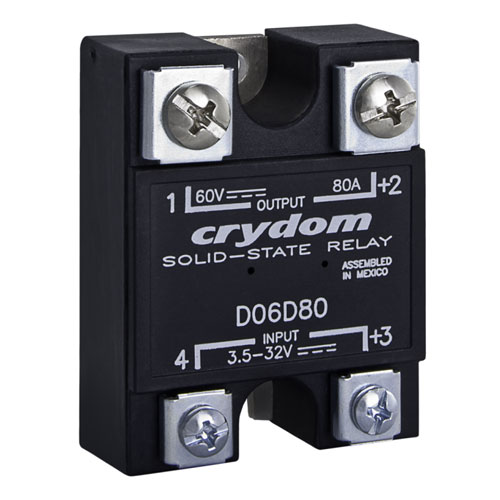

Relays are often used to isolate parts of a circuit, control multiple circuits with a single signal, or provide electrical isolation between different systems. There are various types of electrical relays, each designed for specific applications based on their functionalities and characteristics.
- Electromechanical relay - these relays use an electromagnet to mechanically operate the contacts and are found in applications ranging from industrial controls to automotive systems.
- Solid-state relays (SSR) - the SSR uses semiconductor devices like transistors or thyristors to perform switching operations. They are faster, more durable, and suitable for high-speed and low-power applications, such as computer systems, temperature control, and medical equipment.
- Time delay relays - these relays introduce a time delay before making or breaking the contacts and are suitable for applications where a delay is necessary for proper system operation or safety, such as in motor control circuits or lighting systems.
- Overload protection relay - these relays trip or open the circuit when the current exceeds a predefined threshold to protect electrical circuits and equipment from damage due to excessive current, safeguarding motors and other heavy machinery.
- Reed relays - these relays use a small electromagnet to control the reed switch contacts. They're compact and often used in telecommunications, automatic test equipment, and instrumentation.
- Latch relays - these relays maintain their state (either open or closed) even after the control signal is removed, and they are used in applications where it's essential for the relay to stay in a particular state without continuous power.
- Polarized relays - these relays are designed to operate in a specific direction of current flow, making them suitable for applications where the direction of current is critical.
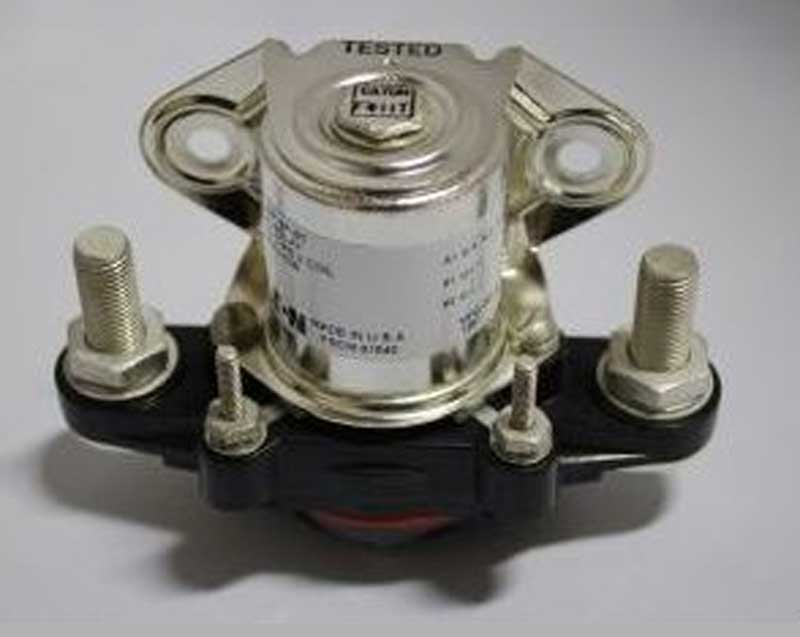

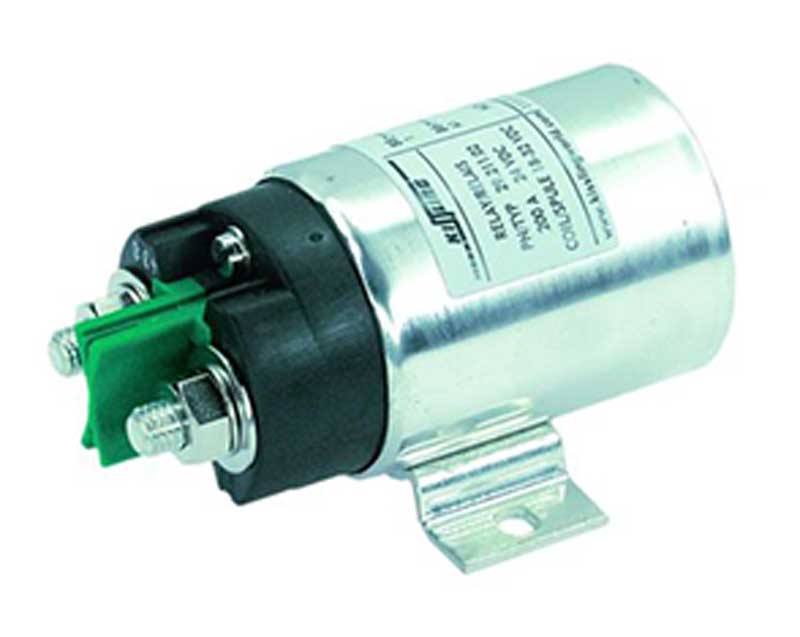

- Power relays - unlike other types of standard relays used in low-power applications, power relays are designed to handle higher current applications with currents ranging from several amperes to hundreds or thousands of amperes and voltages from standard levels up to several thousand volts. They are primarily used in applications where substantial power switching or control is required, such as in controlling electric motors, aerospace applications, power distribution systems, lighting systems, HVAC equipment, and other industrial machinery suitable for demanding requirements in truck, bus, construction, ground support and fork lift vehicle applications.
What is a Contactor?
A contactor is an electrical switch specifically designed to handle high-power circuits, and its primary function is to establish or interrupt the flow of electrical power to a load (typically in applications involving electric motors or large machinery). Contactors consist of an electromagnet that, when energized, pulls down a set of contacts to complete or break an electrical circuit.
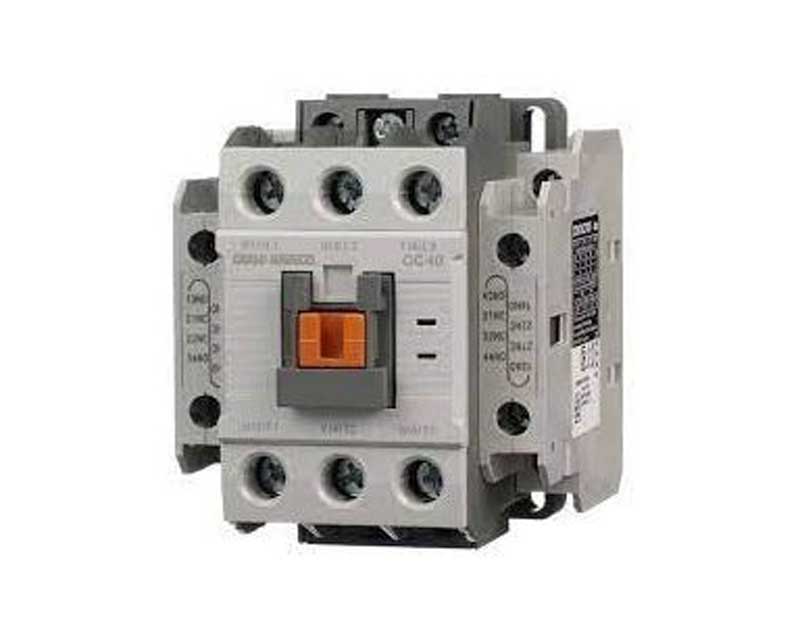

Unlike relays, electrical contactors are robust devices capable of handling heavy currents and are often used when frequently switching or controlling large electrical loads are required. There are various types of industrial contactors, each designed for specific applications based on their functionalities and characteristics.
- Definite purpose contactors - these contactors are designed for specific applications and are often used in HVAC systems, lighting, compressors, and heating systems. They are compact and optimized for particular tasks, offering cost-effective solutions.
- Reversing contactors - these contactors have multiple sets of contacts that allow for the reversal of the motor's direction. They are used in applications where motors need to operate in both forward and reverse directions, such as in conveyor systems or cranes.
- Vacuum contactors - these contactors use a vacuum bottle as an interrupting medium to extinguish the arc when opening contacts. They are highly reliable and are commonly employed in high-voltage applications like power distribution systems, railways, and mining.
- Magnetic contactors - these contactors use an electromagnet to control the contacts and are used in a wide range of industrial applications, including motor controls, lighting, and heating systems.
- Miniature contactors - compact in size, these contactors are suitable for applications where space is limited, like in control panels or small machinery.
- High voltage contactors - these contactors are specifically designed to handle high-voltage applications and are used in power transmission and distribution systems, as well as in electric vehicles and renewable energy systems.
Key Difference Between Contactors and Relays
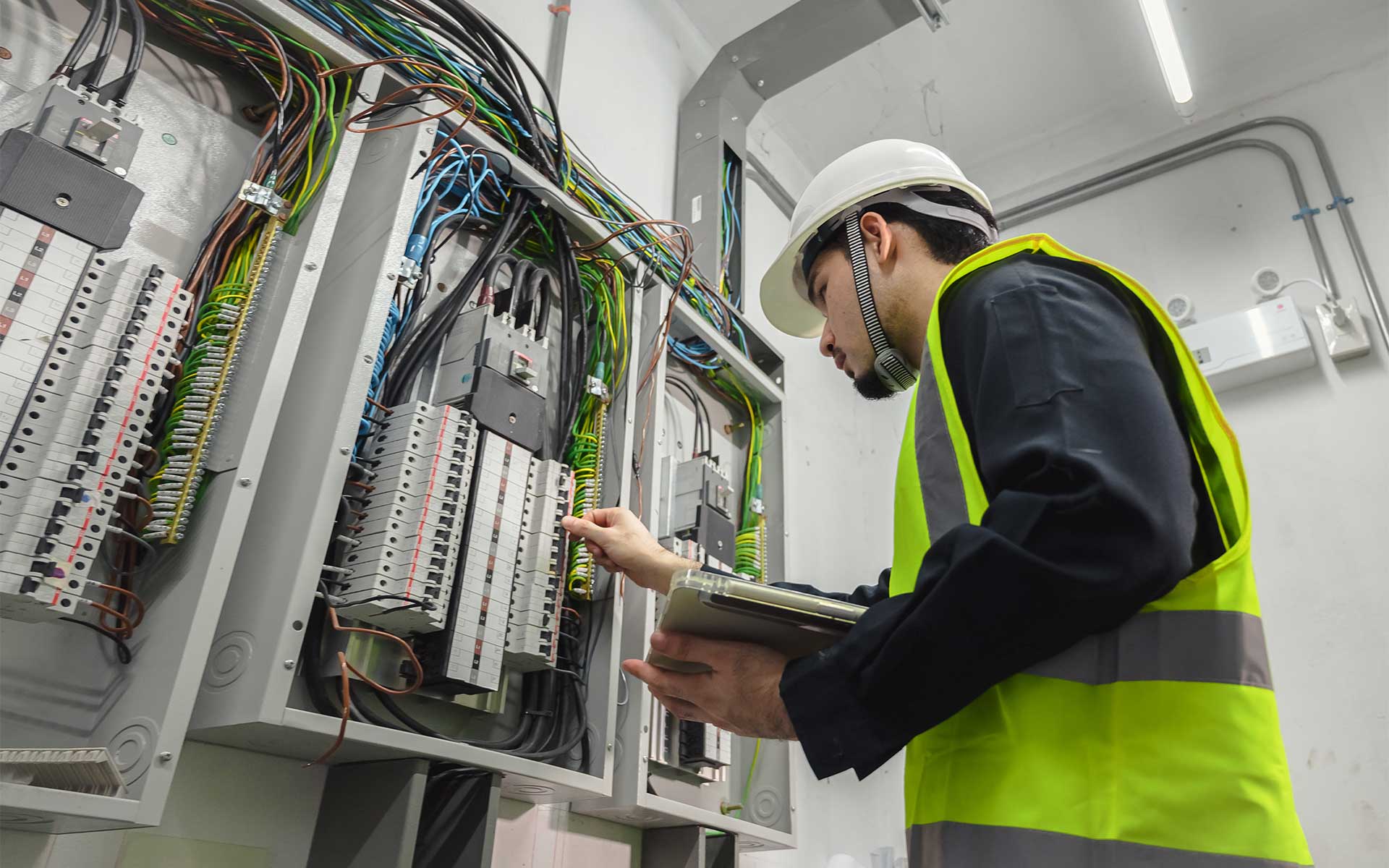

There is often confusion between these two electrical components. However, although electrical relays and contactors serve similar purposes in controlling electrical circuits, they differ in several key aspects: current handling capabilities, voltage ratings, size, and applications.
Let’s begin with current handling capabilities, a key differentiator when comparing the relay vs contactor. Although both include three ratings, i.e., voltage, ampere, and horsepower, these ratings will be higher in a contactor than a relay.
For example, electrical relays typically have an ampere rating of less than 10 A and a horsepower rating of less than 0.5 HP. However, industrial contactors are rated for higher amperes and horsepower. In the case of voltage ratings, relays are generally less than 250 V, and contactors are up to 1000 V.
Also, most relays are designed for lower power control, typically in the range of milliamps to a few amps, and used in control systems to switch smaller loads or signal circuits. Contactors, on the other hand, handle higher current loads, ranging from several amps to several hundred or thousand amps, controlling heavy-duty industrial applications such as motors and machinery.
As you may have guessed, the current handling capabilities of these electrical components correlate to their size. Electrical relays are generally smaller and more compact due to their intended use in lower-power applications. However, electrical contactors are larger and more robust to handle heavy-duty industrial applications with higher currents and mechanical wear.
Applications of Relays in Electrical Systems
Electrical relays have various applications in both household and industrial settings due to their ability to control circuits, signal processing, and safety functions.
Residentially speaking, relays are critical to the operation and safety of various common household systems, including HVAC and home automation systems and appliance and lighting control. For example, electrical relays control the operation of heating and cooling systems by activating or deactivating components like fans, compressors, or heating elements based on temperature settings or control signals. Another example is with light switches and dimmers, where relays help control the flow of electricity to lighting fixtures, allowing for on/off switching and dimming functionality.
In industrial applications, electrical relays help ensure complex systems' efficient operation and safety. They are extensively utilized in control circuits to manage machinery and equipment activation, deactivation, and sequencing. They also act as control elements, responding to signals or control inputs to initiate specific actions within a circuit, enabling precise control and automation of industrial processes.
Moreover, safety relays are fundamental to monitoring critical safety devices and ensuring the proper functionality of safety circuits. By providing functions like emergency shutdowns, fault detection, and overload protection, these relay applications help maintain a healthy working environment by preventing accidents and complying with stringent safety regulations in industrial facilities.
Overall, an electrical relay's ability to isolate circuits, control operations, and detect abnormalities makes electrical relays indispensable to ensuring operational efficiency and safeguarding personnel and machinery in industrial settings.
Applications of Contactors in Electrical Systems


Electrical contactors serve as critical components in industrial electrical systems with high current applications, providing reliable and efficient control over power distribution, motor operations, and various equipment, contributing to the smooth functioning of industrial processes.
For example, contactor uses include helping manage the flow of electricity to motors to enable precise control over industrial machinery and processes. They also play a pivotal role in power distribution systems, regulating the distribution of electrical power to various sections of industrial facilities - including managing and directing power to different circuits to ensure efficient operation of equipment and machinery.
While less common than in industrial settings, electrical contactors find certain applications in households, especially when heavy loads or specialized control are required. For example, contactors can help control devices with high power demands, such as components within pool or spa systems or at-home EV charging units.
How to Choose Between Contactors and Relays
There are several factors to consider when choosing electrical components like a relay or contactor: current, voltage, purpose, environment, and durability.
- Current rating - assess the current requirements of the circuit. Most relays are suitable for lower current applications, typically in the range of milliamps to a few amps, while contactors are designed for high current applications, ranging from several amps to several hundred or thousand amps.
- Voltage rating - evaluate the voltage levels of the circuit. Contactors are built to handle higher voltage power circuits (up to 1000 VAC), while relays typically have lower voltage ratings (up to 250 VAC).
- Purpose and application - determine the intended function within the system. Relays are commonly used in control circuits for signaling or control purposes, whereas contactors are employed in power circuits to control heavy loads such as motors or machinery.
- Environment - consider the physical size and space available in the application. Relays are generally smaller and more compact than contactors, which are larger and bulkier due to their capability to handle higher currents.
- Durability and lifespan - assess the expected frequency of operation and durability requirements. Contactors are built to withstand frequent use and heavy-duty operations, whereas relays might have a shorter lifespan in continuous or high-stress environments.
In conclusion, the confusion between electrical relays and contactors often stems from their shared basic principle of operation, their varying sizes, the terminology used in different contexts, and the potential overlap in their functionalities within certain applications.
However, despite serving similar purposes in controlling electrical circuits, understanding their primary differences can help determine which electrical component is right for a particular application. These differences include their capacity to handle current, physical size, durability, and the specific applications they are intended for, with contactors geared towards heavy-duty industrial use and relays for lighter control and signal switching.


Fortunately, when questions persist, you can rely on Peerless Electronics' expertise to help with questions regarding electrical applications of any size or scope. As the largest stocking distributor for leading manufacturers of these devices, we offer custom-tailored technical support and numerous other value-added services with every purchase. Plus, Peerless Electronics Inc.'s Quality System ensures our services meet or exceed customers' requirements.
Conveniently shop Relays and Contactors online today!
FAQ Summary - Electrical Relays and Contactors
What are the main differences between relays and contactors?
Relays and contactors, while both being electromagnetic switches, have distinct differences in their applications and capacities. Relays are generally used for lower-power applications and can switch multiple contacts simultaneously. They are suitable for controlling small electrical loads. Conversely, contactors are designed to control high-power circuits and are typically used in industrial applications. They can handle higher current loads than relays and are often used to control motors and large lighting systems.
How do I decide whether to use a relay or a contactor for my application?
The decision between using a relay or a contactor depends on the electrical load and the nature of the application. For low-power applications, such as small electronic devices or signal switching, a relay is usually sufficient. If your application involves high power loads, like large motors or heating systems, a contactor is more appropriate due to its higher current handling capability. Always consider factors like voltage, current, and environmental conditions when choosing between a relay and a contactor.
Can relays and contactors be used interchangeably?
While relays and contactors might seem similar, they are not typically interchangeable due to their different load capacities. Relays are suited for lower current applications, whereas contactors are designed to handle higher current loads. Using a relay in a high-power application where a contactor is required can lead to the failure of the relay and potential safety hazards.
What should I consider when selecting a relay or contactor for industrial use?
For industrial applications, consider the current and voltage requirements, the frequency of operation, the type of load (inductive or resistive), and the environmental conditions (like temperature, dust, and humidity). For high-power applications, a contactor would be more appropriate, whereas relays are better for smaller control circuits or lower-power tasks. Additionally, the physical size, durability, and specific features like auxiliary contacts or overload protection should also be considered.
Are there any safety concerns to be aware of when using relays and contactors?
Safety is paramount when dealing with electrical components. Always ensure that the relay or contactor is rated for the specific application it's being used in. Overloading a relay or using a contactor in an inappropriate setting can lead to electrical failures and hazards. It's also important to consider factors like arc suppression and insulation, especially in high-power applications. Regular maintenance and checks are recommended to ensure the safety and longevity of these components.



